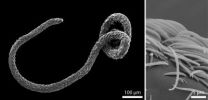(Press-News.org) San Francisco, September 14, 2014—A blood test may be beneficial in indicating neoadjuvant treatment regimens for patients with esophageal squamous cell carcinoma (ESCC), according to research presented today at the American Society for Radiation Oncology's (ASTRO's) 56th Annual Meeting. Results of a nine-year study of patients undergoing concurrent chemotherapy and radiotherapy (CCRT) for esophageal cancer show that levels of two proteins found in the body, vascular endothelial growth factor-A (VEGF-A) and transforming growth factor-β1 (TGF-β1), indicate patients' pathological response and disease-free survival rates.
In order for a cancer to metastasize, the growth of a new network of blood vessels is necessary. This process of forming new blood vessels is called angiogenesis. Tumor angiogenesis is the proliferation of a network of blood vessels that penetrates into cancerous growths, supplying nutrients and oxygen, and removing waste products. VEGF-A plays a crucial role in facilitating tumors to form their supplying vessels needed for growth and metastasis.
TGF-β1 contributes to tumor invasion and systemic tumor spread, and overexpression of TGF-β1 has been reported as a negative predictor in esophageal cancer.
This study evaluated serum (blood) samples of 103 total patients with esophageal squamous cell carcinoma (ESCC) from 2004 to 2013. All patients received preoperative CCRT (taxane-/5-fluorouracil-based chemotherapy and 40 Gy dose of radiation therapy) prior to esophagectomy (surgical removal of a part of the esophagus).
Serum samples were collected from patients before and within one month of completion of CCRT. Researchers first used a proximity ligation assay (PLA) technique to screen for 15 serum biomarkers in 79 patients to evaluate the biomarkers' association with pathological tumor regression on surgery and survival. (A biomarker is a measurable indicator of disease state and can serve as a parameter to measure the progress of disease or the effects of treatment.)
The biomarkers significantly associated with pathological response (PathR) and survival rates were further analyzed by traditional enzyme-linked, immunosorbent assay (ELISA), a wet-lab test that uses antibodies and color change to identify a substance, to confirm initial biomarker findings by PLA in the total group of 103 patients. Associations between serum levels of biomarkers and clinical factors correlating with PathR, disease-free survival (DFS) and overall survival (OS) were evaluated by the Analysis Of Variance (ANOVA) and log-rank tests.
Researchers found that patients with high VEGF-A were less likely to achieve complete tumor regression (a decrease in the size of a tumor or in the extent of cancer in the body), and that the survival rates were lower among patients who had high VEGF-A and high TGF-β1 levels before treatment. With a median follow-up of 33.7 months, the median DFS for the entire patient group was 21.9 months, and the median OS was 42.3 months. Following CCRT, 38 patients (37 percent) had complete tumor disappearance, 44 (43 percent) had minimal disease, and 21 (20 percent) had gross residual tumor at the time of their surgery.
On ELISA, both pre- and post-CCRT VEGF-A levels were significantly correlated with PathR (p=0.042 and 0.019, respectively). Patients with pre-treatment VEGF-A of less than 250 pg/ml were more likely to have pathologically complete response after CCRT (57.1 percent, or 20/35) compared to patients with VEGF-A of more than 250 pg/ml (26.5 percent or 18/68, p=0.002).
Patients with high pre-CCRT VEGF-A/TGF-β1 levels (≥ median) had significantly worse median DFS compared to those with lower levels, and worse median OS (19.2 months vs. 46.2 months, p=0.07). On multivariate analysis, PathR (p END
Blood test for VEGF-A, TGF-B1 could help determine treatment options for esophageal cancer patients
2014-09-15
ELSE PRESS RELEASES FROM THIS DATE:
Shorter course of ADT for high-risk prostate cancer patients yields improved quality of life
2014-09-15
San Francisco, September 14, 2014—High-risk prostate cancer patients who receive radiation therapy (RT) and an 18-month course of androgen deprivation therapy (ADT) recover a normal testosterone level in a shorter amount of time compared to those who receive a 36-month course of ADT, thus resulting in a better quality of life (QOL) and without detriment to long-term outcomes, according to research presented today at the American Society for Radiation Oncology's (ASTRO's) 56th Annual Meeting.
Researchers analyzed data from 561 patients with high-risk prostate cancer from ...
Manuka honey does not decrease pain of radiation-induced esophagitis for lung cancer patients
2014-09-15
San Francisco, September 14, 2014—Patient-reported data indicates that when Manuka honey is prescribed for esophagitis pain during radiation therapy (RT), it is not more effective than standard medical care, according to research presented today at the American Society for Radiation Oncology's (ASTRO's) 56th Annual Meeting.
Esophagitis, inflammation that damages tissues of the esophagus and causes discomfort, is a common and temporary side effect experienced by the majority of lung cancer patients undergoing RT. Small studies have previously been conducted to evaluate ...
Patient-reported data shows RT does not increase risk of lymphedema in node-negative BC patients
2014-09-15
San Francisco, September 14, 2014—A secondary analysis of the National Surgical Adjuvant Breast and Bowel Project B-32 trial (Krag 2010) indicates that radiation therapy (RT) does not increase the incidence of lymphedema in patients with node-negative breast cancer, according to research presented today at the American Society for Radiation Oncology's (ASTRO's) 56th Annual Meeting.
The original NSABP B-32 study was a randomized trial of sentinel node biopsy (SNB) versus SNB + axillary lymph node dissection (ALND) in 5,611 women with clinically node-negative breast cancer. ...
Improved survival shown in early-stage Hodgkin's Disease patients who receive radiation therapy
2014-09-15
San Francisco, September 14, 2014—Patients with stage I and II Hodgkin's Disease who receive consolidated radiation therapy (RT) have a higher 10-year survival rate of 84 percent, compared to 76 percent for patients who did not receive RT; and, the data also shows a decrease in utilization of RT, according to research presented today at the American Society for Radiation Oncology's (ASTRO's) 56th Annual Meeting.
Researchers evaluated clinical features and survival outcomes among 41,502 patients diagnosed with stage I and II Hodgkin's Disease from 1998 to 2011 from a prospectively ...
Advanced esophageal cancer patients who receive RT alone experience less problems when swallowing
2014-09-15
San Francisco, September 14, 2014—Radiation therapy (RT) alone is as effective in decreasing swallowing complications experienced by advanced esophageal cancer patients as RT combined with chemotherapy, thus allowing patients to forgo chemotherapy, according to research presented today at the American Society for Radiation Oncology's (ASTRO's) 56th Annual Meeting.
In this international study that included sites in Australia, New Zealand, Canada and the United Kingdom, researchers assessed the use of palliative chemotherapy combined with RT, or chemoradiotherapy (CRT), ...
Study finds warming Atlantic temperatures could increase range of invasive species
2014-09-15
"The results will allow us to better understand how the fish communities might shift under different climate change scenarios and provide the type of environmental data to inform future decisions relating to the management and siting of protected areas," said Paula Whitfield, a research ecologist at NOAA's National Centers for Coastal Ocean Science (NCCOS) and lead author of the study.
The North Carolina reefs lie within the temperate-tropical transition zone, where historically, both temperate and tropical species live, at their respective range limits. However, water ...
'Jaws' lived in Doncaster
2014-09-15
Sharks, swamps and a tropical rainforest teeming with life – it's not what comes to mind when you think of Yorkshire, England. But for the first time evidence of Doncaster's 310-million-year-old past, including a fossilised shark egg case, has been discovered in a derelict mining tip.
Some of the fossilised plants and creatures may even be new to science, and as well as the egg case, several horseshoe crabs and some previously unrecorded seed pods are amongst the finds. All had been preserved in rocks that formed within the coal and shale deposits in what is one of only ...
Dairy consumption linked to lower blood pressure and cardiovascular disease risk
2014-09-15
Rosemont, Ill., September 15, 2014: Globally, cardiovascular disease (CVD) claims 17 million lives each year, while complications from high blood pressure take an additional 9.4 million.1 New research presented by international scientists at the 12th Euro Fed Lipid Congress in Montpellier, France on September 15, 2014, suggests that milk consumption and dairy may play a beneficial role.
At the Milk and Dairy Products in Human Health session, the association between milk and risk for hypertension and CVD was examined by Dr. Sabita S. Soedamah-Muthu from Wageningen University ...
Think big! Bacteria breach cell division size limit
2014-09-15
This news release is available in German.
The life of a cell is straightforward: it doubles, divides in the middle and originates two identical daughter cells. Therefore, it has been long assumed that cells of the same kind are similarly sized and big cells cannot divide symmetrically. Silvia Bulgheresi's team, University of Vienna, revealed that two non-model bacteria divide regularly despite growing so long to be perceivable by the naked eye. These findings have been published in the renowned journal Nature Communications.
"The microorganisms thriving on the ...
Martian meteorite yields more evidence of possibility of life on Mars
2014-09-15
A tiny fragment of Martian meteorite 1.3 billion years old is helping to make the case for the possibility of life on Mars, say scientists.
The finding of a 'cell-like' structure, which investigators now know once held water, came about as a result of collaboration between scientists in the UK and Greece. Their findings are published in the latest edition of the journal Astrobiology.
While investigating the Martian meteorite, known as Nakhla, Dr Elias Chatzitheodoridis of the National Technical University of Athens found an unusual feature embedded deep within the ...


